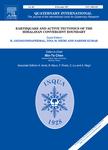版权所有:内蒙古大学图书馆 技术提供:维普资讯• 智图
内蒙古自治区呼和浩特市赛罕区大学西街235号 邮编: 010021

作者机构:Natl Ctr Earth Sci Studies Thiruvananthapuram 695011 Kerala India Phys Res Lab Ahmadabad 380009 Gujarat India Univ Kerala Kariavattom Campus Thiruvananthapuram 695581 Kerala India Cochin Univ Sci & Technol Dept Marine Geol & Geophys Kochi 682022 Kerala India
出 版 物:《QUATERNARY INTERNATIONAL》 (国际第四纪研究)
年 卷 期:2021年第599卷
页 面:72-94页
核心收录:
学科分类:0709[理学-地质学] 081803[工学-地质工程] 07[理学] 08[工学] 0708[理学-地球物理学] 0818[工学-地质资源与地质工程] 0705[理学-地理学]
基 金:National Centre for Earth Science Studies (NCESS) Ministry of Earth Science Government of India
主 题:Indian summer monsoon Sea-level changes Geochemical proxies Radiocarbon dating Lake sediments
摘 要:The lake sediments received wide attention for archiving paleoclimate and paleo sea-level variability during the late Quaternary period. It has also been extensively used to disentangle the interrelationships existing among the regional and the global climate systems. In the present study, the applicability of lake sediments has been the major impetus to delineate the mid-late Holocene climate and sea level variability using a similar to 10 m sediment core retrieved from a protected freshwater lake-the Vellayani lake, southern Kerala, southwest India. The sediment core was investigated using multiproxy approach and was chronologically supported by AMS radiocarbon dates. The results show monsoon intensification and a high sea level during 6430-4390 cal yr BP led to the formation of a coastal lagoon system in the area. Climatically, a marginal reduction in monsoon during 4390-2600 cal yr BP interspersed by an intensified phase during 3800-2600 cal yr BP was observed while concurrently, a sea regression during 4390-2600 cal yr BP restricted sea water influence in the study area. Proxies indicated a significant monsoon reduction during 2600-1000 cal yr BP followed by monsoon intensification post-1000 cal yr BP. After 2600 cal yr BP, a thick pile of alluvial sediments was deposited by the Karamana River which might have hindered the tidal influence and later the basin was transformed into a freshwater lake. The present lake configuration was attained after 440 cal yr BP. Further, comparison of paleoclimate reconstructed from the present study with the global records revealed a teleconnection of Indian monsoon with the global climate system.